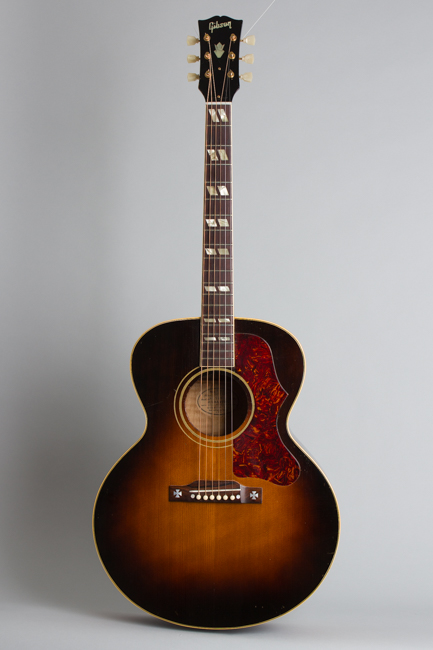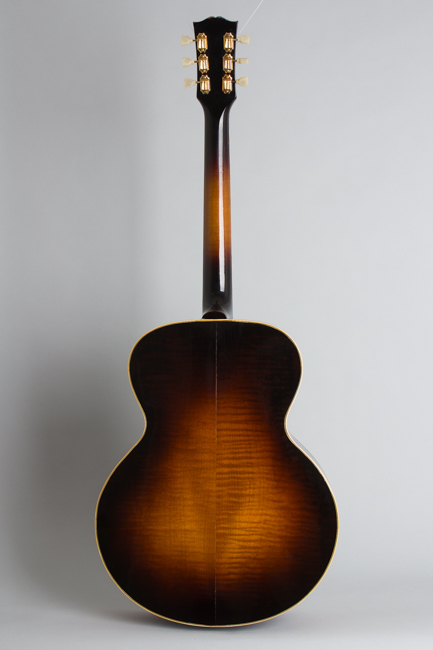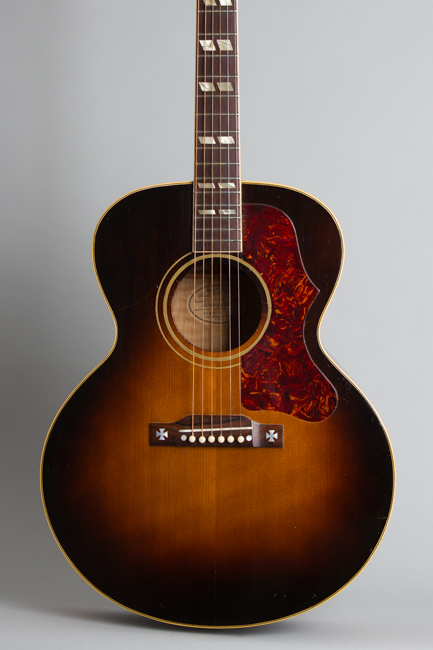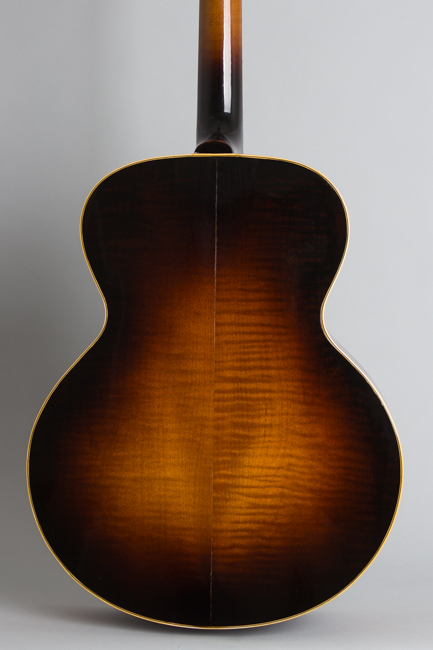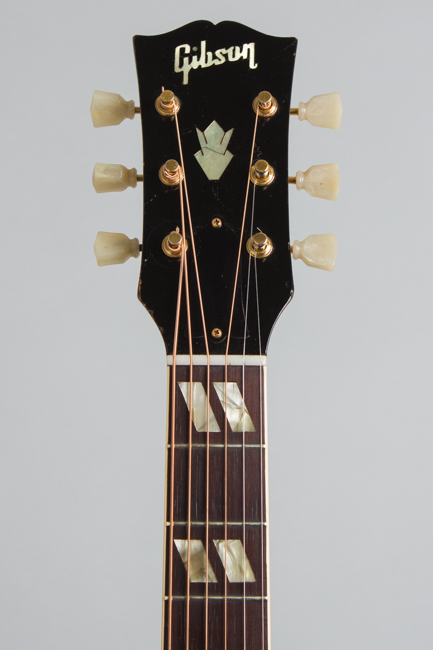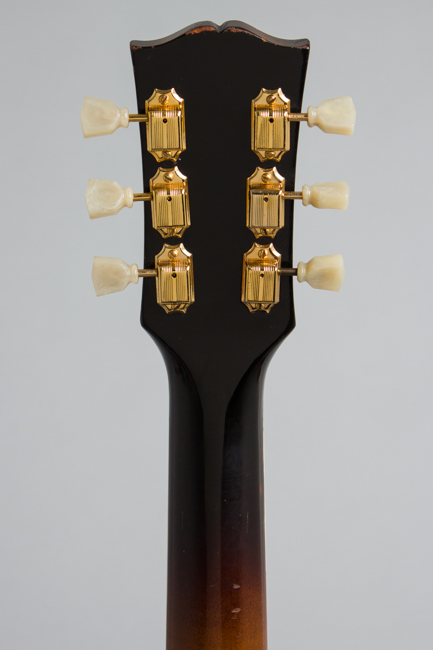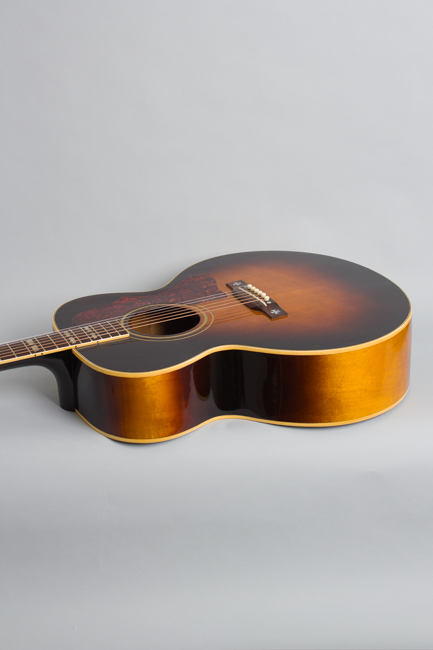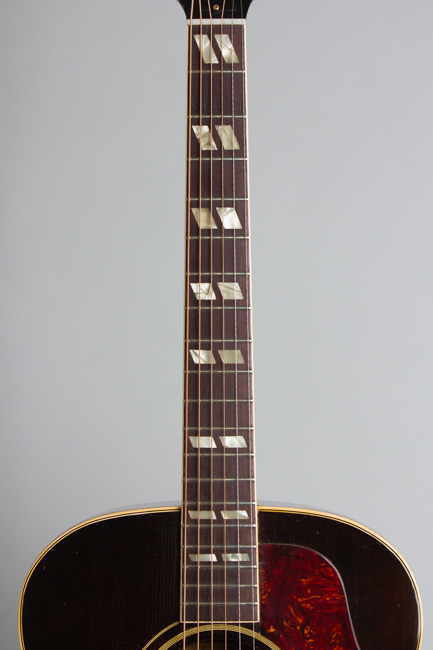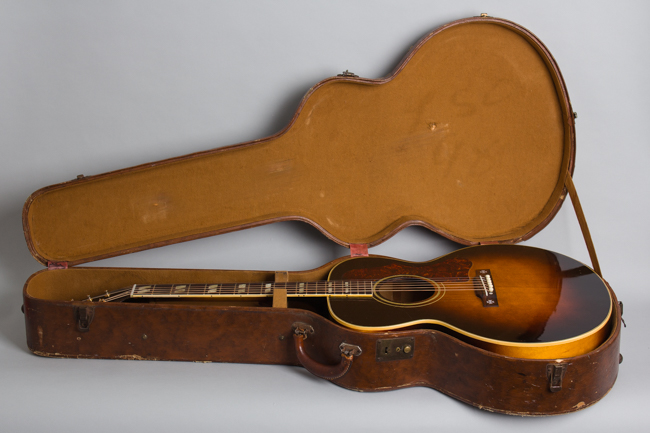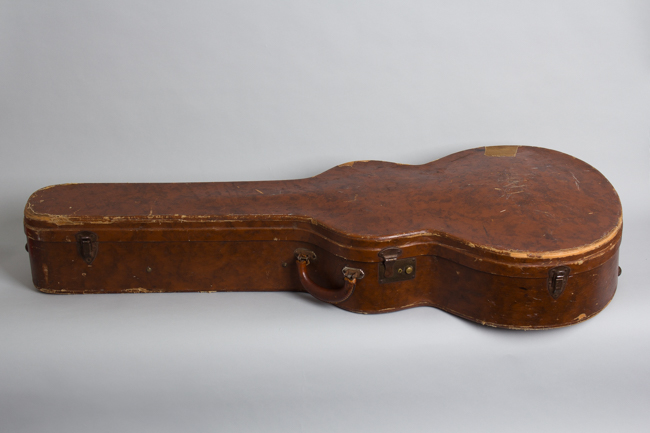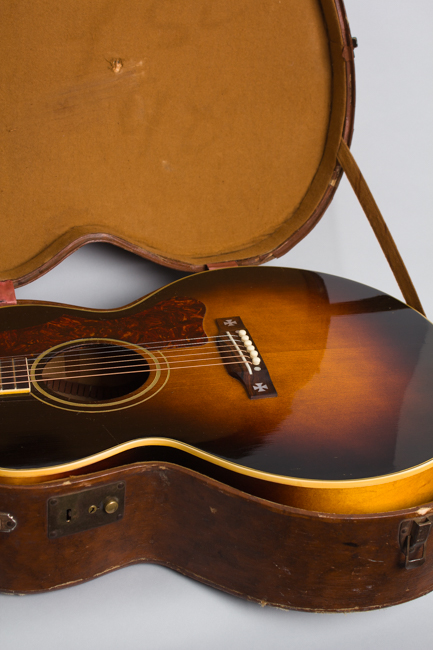Gibson J-185 Flat Top Acoustic Guitar (1953)
Gibson J-185 Model Flat Top Acoustic Guitar (1953), made in Kalamazoo, Michigan, serial # A15891, sunburst lacquer finish, flame maple back and sides, spruce top; mahogany neck with rosewood fingerboard, original brown hard shell case.
This is a truly beautiful example of an original sunburst Gibson J-185, really about the nicest of these highly respected flat tops we have ever had. This model has gained a formidable reputation over the decades as one of the absolute finest of all Kalamazoo-made flat-tops. To some players for certain styles this unique 16" wide, narrow waisted maple Jumbo is simply one of the best flat tops ever made by anybody. In production only from 1951-'58, this model sadly never really established itself at the time but has garnered a splendid reputation over the decades since.
The serial number on the white "Artist" soundhole label indicates this J-185 was shipped in very early December 1953 and a Y-coded Factory Order Number on the heelblock dates to the same year. It is one of 648 total sunburst J-185's Gibson built over the entire decade of the 1950s, 119 of which left Kalamazoo in 1953. These numbers are VERY small for such a well-regarded guitar, but this model suffered from the "Midline Blues". The J-185 listed for $220 (plus $40 for the "Faultless" hard case) in 1953; it seems most folks who could afford that sort of price went all out and bought the top-line J-200, while the rest stuck with the familiar and more affordable slope-shoulder Jumbo family. After several years of slumping sales the last J-185 was shipped in 1959.
The J-185 represents Gibson's second attempt to create a less expensive guitar to complement the top-of-the-line "King of the Flat-tops" SJ-200, the first being the virtually dead-on-arrival SJ-100 of 1939-41. This is basically a plainer 16" wide version of the more overtly "yee-haw" 17" J-200. The slightly smaller body retains the same narrow-waisted shape and materials but has lighter construction resulting in a handier, much more responsive guitar. The cosmetics are a bit plainer, but still make for an impressive-looking instrument. This beauty has subtly flamed maple back and straight-grained spruce top under a shaded sunburst finish. The top and back are triple-bound and the tortoise celluloid pickguard is the same shape as the J-200 but thinner, and not ornamented with any engraving.
The slim but fairly deep round-profile one-piece mahogany neck is topped with a bound rosewood fingerboard sporting Gibson's classic double parallelogram inlay. The unbound headstock has a crown inlay on the face and mounts gold-plated Kluson Deluxe tuners with keystone buttons. A unique feature of the J-185 is pearl Maltese crosses inlaid on the wings of the "belly-up" rosewood bridge, an attractive if eccentric cosmetic touch reserved for this model alone.
Since the 1960s the J-185's unique sound, feel (and relative rarity) have made it the most sought-after of all post-war Gibson flat-tops. A few name players had one in the 1960s, notably blues legend Skip James at the end of his career. A different blues connection made them much desired among fingerstyle players: Reverend Gary Davis favored Gibson's J-200 during the 1960s, but the lighter and more responsive J-185 is a preferred instrument among many who follow in the Reverend's stylistic wake. This is a really superb example of this very versatile guitar with an exceptionally smooth, rich and expansive tone for a maple bodied instrument. This is one of those guitars that truly lives up to its considerable reputation, simply one of Gibson's greatest if originally underappreciated instruments.
Overall length is 41 in. (104.1 cm.), 16 1/16 in. (40.8 cm.) wide at lower bout, and 4 5/8 in. (11.7 cm.) in depth at side, taken at the end block. Scale length is 24 3/4 in. (629 mm.). Width of nut is 1 11/16 in. (43 mm.).
This is a beautiful and superb playing 70+ year old example of this much-desired instrument, really about the nicest we have had. It apparently has not had much serious play over many decades despite being a spectacular sounding guitar. The original lacquer finish shows typical light checking and some very minor dings, dents and scrapes but is overall very clean, still with the original patina. The top has far less pick wear than most, only a light scratch off the upper waist and some dinks to the sounhole edges. The back of the neck is mostly quite clean with several small but feelable small dinks behind the 3rd fret area, there are some small typical chips to the headstock edges.
Structurally the guitar is excellent. The back shows a re-seal to both ends of the center seam, with finish touch-up at either end and the entire back looks like it was polished out a bit as part of this process, but not given a wholesale overspray. There are no other cracks anywhere, fantastic for a maple jumbo of this period. The top center seam has a TINY bit of chipping to the finish from expansion but does not appear to have ever opened up.
The neck has been cleanly reset and there is fairly discreet touchup around the heel seam, well done and only really noticeable under black light inspection. The original bridge is fully intact; it appears to have been reglued with a little disturbance to the top finish along the front edge. The bone saddle and nut are newer. Internally the small maple bridge plate is original in excellent shape and the bridge retaining bolts are still intact. One small wing brace has what looks like an old hide glue repair under it, but that may just be sloppy fitting at the factory.
The original frets have been crowned down lightly but still play fine. This guitar is lovely to play and sounds divine, both crisp and warm and very responsive for a large bodied guitar. It rests happily in the original brown Lifton HSC, not as clean with more wear than the guitar but still fully serviceable. Overall Excellent Condition.
This is a truly beautiful example of an original sunburst Gibson J-185, really about the nicest of these highly respected flat tops we have ever had. This model has gained a formidable reputation over the decades as one of the absolute finest of all Kalamazoo-made flat-tops. To some players for certain styles this unique 16" wide, narrow waisted maple Jumbo is simply one of the best flat tops ever made by anybody. In production only from 1951-'58, this model sadly never really established itself at the time but has garnered a splendid reputation over the decades since.
The serial number on the white "Artist" soundhole label indicates this J-185 was shipped in very early December 1953 and a Y-coded Factory Order Number on the heelblock dates to the same year. It is one of 648 total sunburst J-185's Gibson built over the entire decade of the 1950s, 119 of which left Kalamazoo in 1953. These numbers are VERY small for such a well-regarded guitar, but this model suffered from the "Midline Blues". The J-185 listed for $220 (plus $40 for the "Faultless" hard case) in 1953; it seems most folks who could afford that sort of price went all out and bought the top-line J-200, while the rest stuck with the familiar and more affordable slope-shoulder Jumbo family. After several years of slumping sales the last J-185 was shipped in 1959.
The J-185 represents Gibson's second attempt to create a less expensive guitar to complement the top-of-the-line "King of the Flat-tops" SJ-200, the first being the virtually dead-on-arrival SJ-100 of 1939-41. This is basically a plainer 16" wide version of the more overtly "yee-haw" 17" J-200. The slightly smaller body retains the same narrow-waisted shape and materials but has lighter construction resulting in a handier, much more responsive guitar. The cosmetics are a bit plainer, but still make for an impressive-looking instrument. This beauty has subtly flamed maple back and straight-grained spruce top under a shaded sunburst finish. The top and back are triple-bound and the tortoise celluloid pickguard is the same shape as the J-200 but thinner, and not ornamented with any engraving.
The slim but fairly deep round-profile one-piece mahogany neck is topped with a bound rosewood fingerboard sporting Gibson's classic double parallelogram inlay. The unbound headstock has a crown inlay on the face and mounts gold-plated Kluson Deluxe tuners with keystone buttons. A unique feature of the J-185 is pearl Maltese crosses inlaid on the wings of the "belly-up" rosewood bridge, an attractive if eccentric cosmetic touch reserved for this model alone.
Since the 1960s the J-185's unique sound, feel (and relative rarity) have made it the most sought-after of all post-war Gibson flat-tops. A few name players had one in the 1960s, notably blues legend Skip James at the end of his career. A different blues connection made them much desired among fingerstyle players: Reverend Gary Davis favored Gibson's J-200 during the 1960s, but the lighter and more responsive J-185 is a preferred instrument among many who follow in the Reverend's stylistic wake. This is a really superb example of this very versatile guitar with an exceptionally smooth, rich and expansive tone for a maple bodied instrument. This is one of those guitars that truly lives up to its considerable reputation, simply one of Gibson's greatest if originally underappreciated instruments.
Overall length is 41 in. (104.1 cm.), 16 1/16 in. (40.8 cm.) wide at lower bout, and 4 5/8 in. (11.7 cm.) in depth at side, taken at the end block. Scale length is 24 3/4 in. (629 mm.). Width of nut is 1 11/16 in. (43 mm.).
This is a beautiful and superb playing 70+ year old example of this much-desired instrument, really about the nicest we have had. It apparently has not had much serious play over many decades despite being a spectacular sounding guitar. The original lacquer finish shows typical light checking and some very minor dings, dents and scrapes but is overall very clean, still with the original patina. The top has far less pick wear than most, only a light scratch off the upper waist and some dinks to the sounhole edges. The back of the neck is mostly quite clean with several small but feelable small dinks behind the 3rd fret area, there are some small typical chips to the headstock edges.
Structurally the guitar is excellent. The back shows a re-seal to both ends of the center seam, with finish touch-up at either end and the entire back looks like it was polished out a bit as part of this process, but not given a wholesale overspray. There are no other cracks anywhere, fantastic for a maple jumbo of this period. The top center seam has a TINY bit of chipping to the finish from expansion but does not appear to have ever opened up.
The neck has been cleanly reset and there is fairly discreet touchup around the heel seam, well done and only really noticeable under black light inspection. The original bridge is fully intact; it appears to have been reglued with a little disturbance to the top finish along the front edge. The bone saddle and nut are newer. Internally the small maple bridge plate is original in excellent shape and the bridge retaining bolts are still intact. One small wing brace has what looks like an old hide glue repair under it, but that may just be sloppy fitting at the factory.
The original frets have been crowned down lightly but still play fine. This guitar is lovely to play and sounds divine, both crisp and warm and very responsive for a large bodied guitar. It rests happily in the original brown Lifton HSC, not as clean with more wear than the guitar but still fully serviceable. Overall Excellent Condition.
